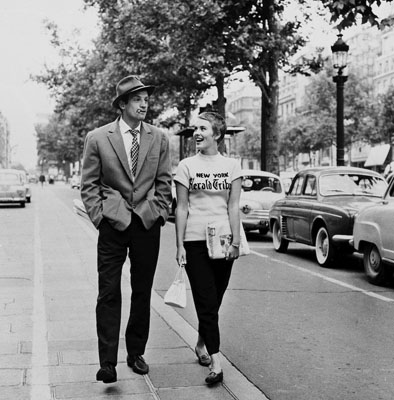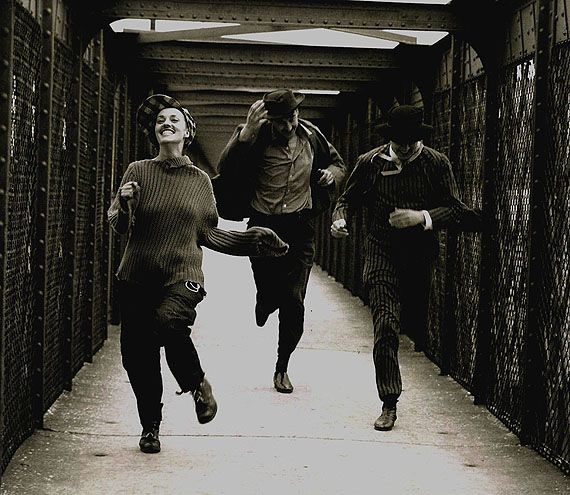
Raymond Cauchetier »
Movie set reporter
Exhibition: 25 Jan – 3 Mar 2012

Polka Galerie
Cour de Venise, rue Saint-Gilles 12
75003 Paris
+33 (0)1-76214130
contact@polkagalerie.com
www.polkagalerie.com
Tue-Sat 11-19:30

Raymond Cauchetier
Movie set photographer
“Raymond’s photographs are themselves, central works of the French New Wave.“ (Richard Brody, in Aperture Magazine #197, 2009)
Raymond Cauchetier (Paris, 1920), fundamental photo- grapher of the new wave, was also a great reporter during the Indochina war. At the end of the war, Raymond Cau- chetier stayed in Cambodia and met Marcel Camus, who invited him to follow the filming of his movie, produced in Cambodia. This chance encounter with the 7th Art is the beginning of a prestigious career as a set photographer.
During more than ten years, Raymond Cauchetier worked with the greatest moviemakers of the new wave: Mel- ville, Truffaud, Godard, Tavernier and Chabrol. His eye and talent seduced all of them. On sets, Raymond Cauchetier works as a reporter and follows his instinct. A revolution in the world of set photography: with Raymond Cauche- tier, it becomes alive.
Raymond Cauchetier is the author of the famous shot of Jean-Paul Belmondo and Jean Seberg walking down the Champs-Elysées during the making of “A bout de souffle”. He remembers: “what works for movies might not for photography. So, for this photograph, I took the actors down the avenue and had them re-enact the scene. This was a first; only the professionals know that this photograph was not taken during the movie”. He adds: “When I understood that I was witnessing a cine- matographic revolution, I decided to cover it.”
Polka Galerie exhibits for the first time in France the pho- tographs of Raymond Cauchetier. Aside from his famous pictures, the gallery presents his works from Indochina, Saigon and Angkor. Two universes closely linked, since one allowed the other to emerge.
Raymond Cauchetier embodied the new wave; the 2012 Academy Awards will pay tribute to him in Los Angeles.
Raymond Cauchetier
Le cinéma du reporter
« Les photographies de Raymond Cauchetier sont, en elles-mêmes, des œuvres centrales de la Nouvelle Vague» Richard Brody, in Aperture Magazine #197, 2009
Raymond Cauchetier (Paris,1920) photographe incontour- nable de la Nouvelle Vague, fut également grand reporter durant la guerre d’Indochine. A la fin du conflit, Raymond Cauchetier reste au Cambodge et rencontre par hasard, en 1956 Marcel Camus, qui l’invite à suivre le tournage de son film réalisé dans le pays. Cette rencontre avec le 7e Art marque le point de départ d’une prestigieuse carrière de photographe de plateau.
Pendant plus de dix ans, Raymond Cauchetier travaille avec les grands réalisateurs de la Nouvelle Vague : Mel- ville, Truffaud, Godard, Tavernier ou Chabrol. Tous sont séduits par son habilité et son œil. Sur les plateaux, Ray- mond Cauchetier travaille en reporter et laisse libre cours à son instinct. Une révolution dans le monde de la photo- graphie de cinéma à cette époque : avec Raymond Cau- chetier, la photographie de plateau prend vie.
Raymond Cauchetier est l’auteur du célèbre cliché de Jean- Paul Belmondo et Jean Seberg descendant les Champs- Elysées pendant le tournage d’« A bout de souffle ». Il se souvient : « Ce qui est bon pour le cinéma ne l’est pas forcément pour la photographie. Alors, pour cette photo, j’ai préféré emmener les comédiens en bas de l’avenue pour rejouer la scène. C’est une première ; seuls les pro- fessionnels savent que cette photo n’est pas une photo de film. » Il poursuit : « Quand j’ai compris que j’assistais à une révolution du cinéma, j’ai fait du reportage sur le film. »
La galerie Polka expose pour la première fois en France les photographies de Raymond Cauchetier. Aux côtés de ses célèbres clichés, la galerie présentera ses travaux sur l’Indochine, Saigon et Angkor. Deux univers liés car l’un a permis l’autre.
Raymond Cauchetier a incarné la Nouvelle Vague. Une grande exposition lui est consacrée, à Los Angeles, dans le cadre de la cérémonie des Oscars 2012.